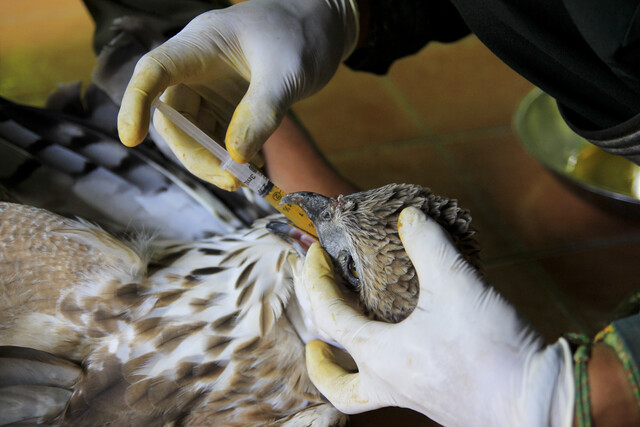Online Class: Advanced Dog Training Techniques

-
10Lessons
-
11Exams &
Assignments -
7Hours
average time -
0.7CEUs
Course Description
Advanced Training for Man's Best Friend Going Beyond the Basics of Dog Training
Throughout this course, we'll dive into the advanced world of dog training, first by starting off with a bit of dog training history and breed recognition, which will offer insight to breeds' intelligence. You'll learn the common advanced commands like stop, steady, back up, and give, and then determine whether or not you and Fido are ready for Off-Lead Training, which can be fun and tedious at the same time. We'll explore various methods of advanced training including Clicker Training and the theory of the Monks of New Skete.
After covering methodology, you'll discover what it takes for a dog to develop into a working dog like a seeing eye, police, or search and rescue dog. For those with a competitive nature, we'll discuss different levels of competition including conformation (dog shows), tracking training, and agility. And why would you have a dog if you couldn't teach him some fun tricks and games so you can show him off to your friends and family!
Toward the end of the course you'll learn more about some of the advanced tricks like bow, roll over, through the hoop, the four-footed fax, and wiggle, giggle, freeze! Lastly, if you're still yearning for more information about your dog's breed, where to find competitions or more training information, we'll talk about the major dog clubs and organizations that exist today. Grab a bag of treats, your leash and your pooch, it's time to have some good ol' barkin' fun!
Course Lessons
Lesson 1. Dog Training Evolution
 Lesson 1 Video
Lesson 1 Video Review Practice Worksheet: Lesson-1-WordSearch-8030.pdf
Review Practice Worksheet: Lesson-1-WordSearch-8030.pdf Lesson discussions: First Command; Reasons for Taking this Course
Lesson discussions: First Command; Reasons for Taking this Course Complete Assignment: An Introduction
Complete Assignment: An Introduction Assessment: Lesson 1: History of Dog Training
Assessment: Lesson 1: History of Dog Training
Lesson 2. The Science of Sniffing: How Dogs Recognize People and Pets by Scent
 Lesson 2 Video
Lesson 2 Video Review Practice Worksheet: Lesson-2-WordSearch-8032.pdf
Review Practice Worksheet: Lesson-2-WordSearch-8032.pdf Assessment: Lesson 2: Dog intelligence
Assessment: Lesson 2: Dog intelligence
Lesson 3. Beyond Basics: Elevating Your Dog's Obedience
 Lesson 3 Video
Lesson 3 Video Review Practice Worksheet: Lesson-3-WordSearch-8034.pdf
Review Practice Worksheet: Lesson-3-WordSearch-8034.pdf Assessment: Lesson 3: Advanced Commands In Detail
Assessment: Lesson 3: Advanced Commands In Detail
Lesson 4. Off-Leash Training: Mastering Trust
 Lesson 4 Video
Lesson 4 Video Review Practice Worksheet: Lesson-4-WordSearch-8036.pdf
Review Practice Worksheet: Lesson-4-WordSearch-8036.pdf Assessment: Lesson 4: Off-lead Training
Assessment: Lesson 4: Off-lead Training
Lesson 5. Karen Pryor's Clicker Training Unveiled
 Lesson 5 Video
Lesson 5 Video Review Practice Worksheet: Lesson-5-WordSearch-8038.pdf
Review Practice Worksheet: Lesson-5-WordSearch-8038.pdf Lesson discussions: Clicker Training
Lesson discussions: Clicker Training Assessment: Lesson 5: Clicker Training
Assessment: Lesson 5: Clicker Training
Lesson 6. Time-Savvy Dogs: Embracing Their Natural Rhythms
 Lesson 6 Video
Lesson 6 Video Review Practice Worksheet: Lesson-6-WordSearch-8040.pdf
Review Practice Worksheet: Lesson-6-WordSearch-8040.pdf Assessment: Lesson 6: Monks Of New Skete Training Theory
Assessment: Lesson 6: Monks Of New Skete Training Theory
Lesson 7. Furry Heroes in Action: Search and Rescue Dogs' Vital Role
 Lesson 7 Video
Lesson 7 Video Review Practice Worksheet: Lesson-7-WordSearch-8042.pdf
Review Practice Worksheet: Lesson-7-WordSearch-8042.pdf Assessment: Lesson 7: Working Dog Training
Assessment: Lesson 7: Working Dog Training
Lesson 8. Unleashing Canine Potential: Dog Sports and Training Fun
 Lesson 8 Video
Lesson 8 Video Review Practice Worksheet: Lesson-8-WordSearch-8044.pdf
Review Practice Worksheet: Lesson-8-WordSearch-8044.pdf Assessment: Lesson 8: Dog Sports
Assessment: Lesson 8: Dog Sports
Lesson 9. Fun Dog Tricks and Games
 Lesson 9 Video
Lesson 9 Video Review Practice Worksheet: Lesson-9-WordSearch-8046.pdf
Review Practice Worksheet: Lesson-9-WordSearch-8046.pdf Lesson discussions: Fun Tricks
Lesson discussions: Fun Tricks Assessment: Lesson 9: Fun Tricks And Games
Assessment: Lesson 9: Fun Tricks And Games
Lesson 10. Deepening the Canine Connection: Exploring Dog Organizations
 Lesson 10 Video
Lesson 10 Video Review Practice Worksheet: Lesson-10-WordSearch-8048.pdf
Review Practice Worksheet: Lesson-10-WordSearch-8048.pdf Lesson discussions: What is your opinion of this course?; Program Evaluation Follow-up Survey (End of Course)
Lesson discussions: What is your opinion of this course?; Program Evaluation Follow-up Survey (End of Course) Assessment: The Final Exam
Assessment: The Final Exam
Learning Outcomes
- Define the historical evolution of dog training by identifying key milestones from early domestication to modern techniques based on positive reinforcement.
- Demonstrate understanding of different dog breeds' unique traits by categorizing them according to their trainability and providing examples of suitable training approaches.
- Define the concept of canine scent identification and explain how the number of olfactory receptors in dogs enhances their ability to distinguish various smells.
- Demonstrate an understanding of differing canine intelligence levels by identifying examples of dog breeds and their natural aptitudes in tasks such as obedience, agility, or scent work.
- Implement the STEADY command to guide dogs in maintaining calm, controlled movement in various environments.
- Define the STOP command and demonstrate the ability to make a dog halt and lie down from a distance.
- Demonstrate effective off-lead training techniques, including the use of retractable leashes, indoor drag leads, and long-line practice, in various environments.
- Identify the behavioral signs of a dog ready for off-lead training, such as maintaining eye contact and quick, responsive behavior.
- Define clicker training and describe its operant conditioning principles used in positive reinforcement for dog training.
- Demonstrate successful execution of basic clicker training techniques, including proper timing of clicks and delivery of rewards, in training a dog.
- Define the key principles of holistic dog training by describing how understanding canine psychology, building trust, and using positive reinforcement improve the dog-owner relationship.
- Demonstrate the application of the Monks of New Skete's training theory by practicing real-world training scenarios that strengthen the human-dog connection through mutual respect and understanding.
- Recognize the different roles and breeds associated with working dogs, such as service, police, and therapy dogs, and their specific skills and training.
- Demonstrate mastery of lesson content at levels of 70% or higher.
Additional Course Information

- Document Your Lifelong Learning Achievements
- Earn an Official Certificate Documenting Course Hours and CEUs
- Verify Your Certificate with a Unique Serial Number Online
- View and Share Your Certificate Online or Download/Print as PDF
- Display Your Certificate on Your Resume and Promote Your Achievements Using Social Media







